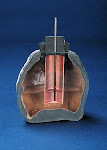 |
| http://en.wikipedia.org/wiki/Electroshock_weapon |
Tasers have been in the news a lot as their use by police has become routine. Touted as a "less-than-lethal" weapon - originally sold to the public as an alternative to firearms - they have instead become a useful cattle prod to....well.....prod the cattle known as We the People.
"Brooks was seven months pregnant and driving her 11-year-old son to school in 2004. Police clocked her going 32 miles per hour in a 20 mph school zone. She handed over her driver's license but denied wrongdoing.
A speeding citation was issued but the woman refused to sign it as state law required. Brooks later claimed she mistakenly believed signing the ticket was an admission of guilt. An argument ensued with two police officers. A federal appeals court later said, "she remained defiant even after (Officer) Jones told her she'd be arrested if she continued to refuse."
A police sergeant soon arrived and informed the motorist that force would be applied if she did not get out of her vehicle as ordered. Brooks refused. A Taser electro-shock weapon was displayed, and officers warned her it would be used if there was further resistance. Brooks explained her pregnancy, and later claimed one of the officers replied, "Well, don't do it in her stomach, do it in her thigh."
The Taser was applied in a "drive-stun" mode three times in a one-minute span -- in her thigh, arm, then neck, according to court testimony.
...but are Tasers really that safe?
Our heart has its own internal pacemaker called the SA (Sinoatrial Node.) The SA node generates a DC impulse that travels to the AV (AtrioVentricular) node- where it is delayed they spreads to other conductive fibres in the heart causing the muscles/chambers to contract properly to drive blood through the circulatory system.
The first pacemakers were AC (Alternating Current) where "house current" was applied to the heart - and the operator relied upon luck for the Alternating Current applied to "catch" the impulses of the SA node at the right time bringing the heart back to function.
 |
| http://www.hrsonline.org/news/ep-history/timeline/1940s.cfm " |
So we know electrical current can be used to stop the heart. The researchers realized there existed a vulnerable period in the heart's electrical cycle where a heart could be sent into fibrillatioin:
The Ventricular Vulnerable Period
Am JPhysiol 1940; 131:309-316 LINK SEE ABOVE PARAGRAPH
In 1940 Wiggers and Wegria established beyond doubt the existence of the ventricular vulnerable period by elegant experiments that confirmed previous less striking observations.
A. "Repeated tests on seventeen different dogs demonstated consistently that stimuli falling during the rise of interventricular pressure are without effect, that those applied during the summit at various intervals up to about 0.06 second before the end of contraction, marked by the incisura, produce either a small premature contraction early in following diastole, or ventricular fibrillation, and that those given during isometric relaxation or subsequent diastole cause premature contractions only. "
B. "A considerable portion of late systole constitutes a (vulnerable period), during which alone stimuli are effective in inducing ventricular fibrillation. This corresponds roughly to the T wave of a standard electrocardiogram, although in our experience great variability exists in the relation of this wave to the end of systole."
Wiggers CJ, Wegria R, Pinera B.The effects of myocadial ischaemia on the fibrillation threshold.Am JPhysiol 1940; 131:309-316 LINK SEE ABOVE PARAGRAPH
Now what about Tasers?
Tasers are AC current generators that deliver a small current at high voltage. When the prongs of the Taser are used to penetrate the skin - the protective current-limiting features of human skin are nulled - and the current delivered becomes variable - and higher than it would be if the skin were not broken.
This is the same reason we are told not to handle electrical appliances while standing in water or while our hands are wet. This is precisely the same effect gained when Taser prongs are fired into or jabbed into the skin. This electrical resistance variability varies with circumstances, victim etc... It cannot be stated as a fixed amount.
We know people vary greatly from individual to individual. So do the states of heart health vary - a Taser shock to one person is not necessarily of equal impact on another individual. Further - physical size has a tendency to distribute the current over a greater area.
Are Tasers "safe?"
Tasers are cattle prods.
"In the beginning of the design, police used electric cattle prods as electric shock prods." LINK HERE
CONCLUSION
Tasers are not "safe" - because it is impossible to define the conditions for use upon which they would prove safe for everybody.
Getting Tased cannot be good for anyone. The falls and other injuries that have proven to follow - demonstrate they're used as a weapon of coercion, torture and death.
I wonder if anyone is developing conductive clothing to counter these weapons?










































































.jpg)


















